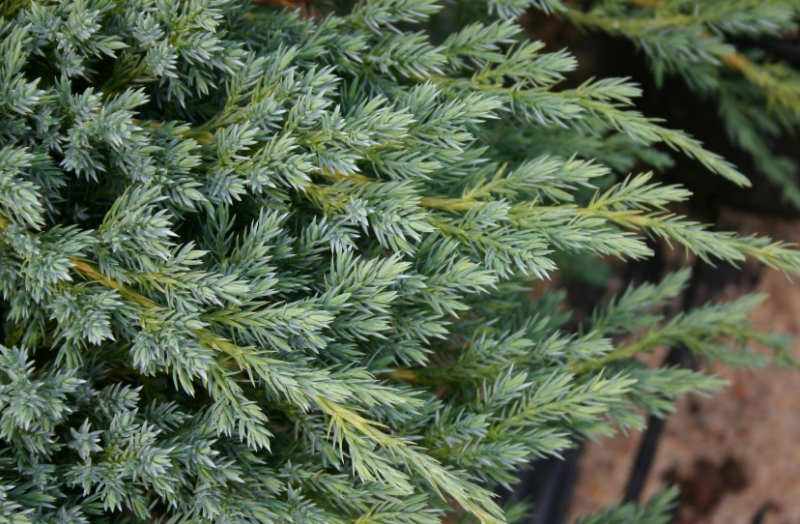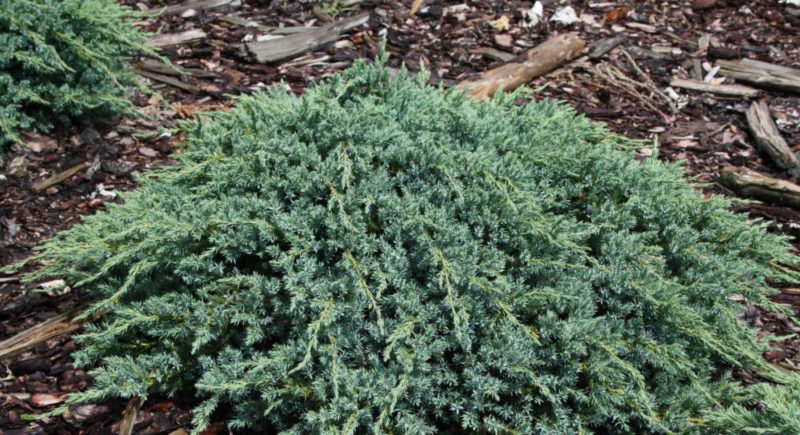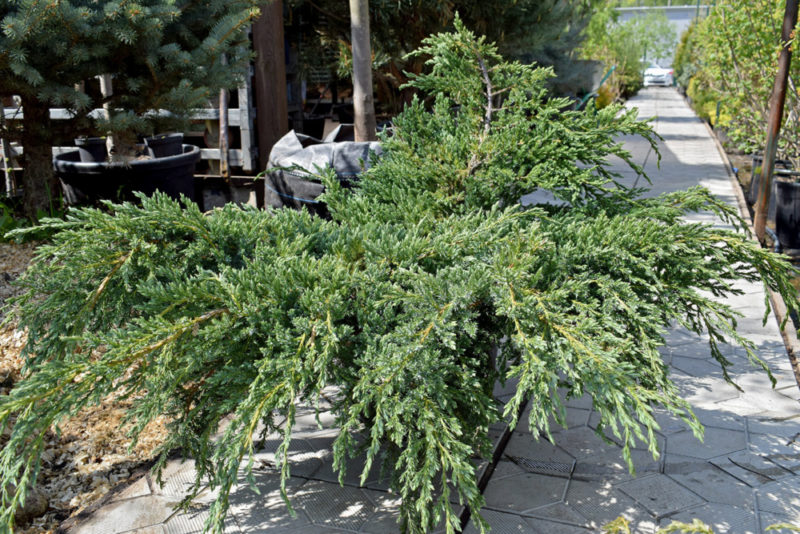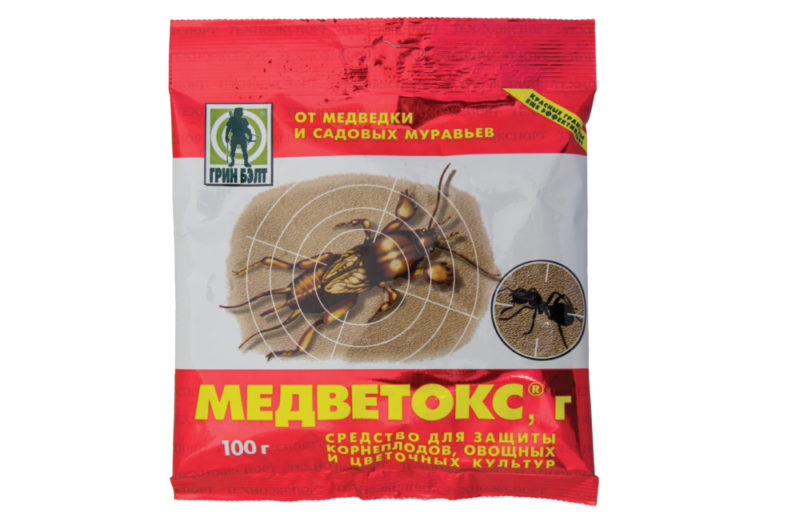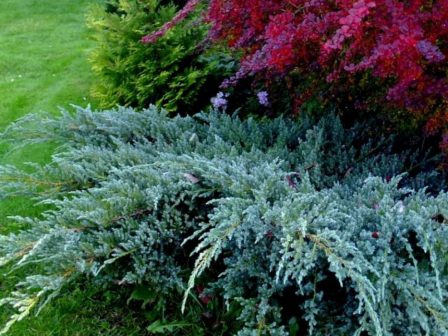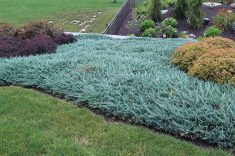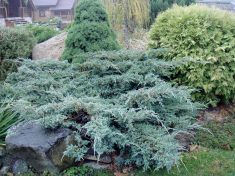Juniper "Blue Carpet" is classified as scaly. This is a low shrub whose branches are located horizontally above the ground. Annual growth is about 25 cm in each direction.
Material Content:
Description of Juniper variety “Blue Carpet”
The plant is unpretentious and hardy, feels good even in the Leningrad region, unlike other scaly junipers.
There are years when a variety lives up to its name “blue carpet”, increasing to half a meter in diameter.
It is interesting in that after spring pruning it is well restored and gives a noticeable increase. This juniper can grow to large sizes in width. He has bluish-green spiny needles.
The variety is frost-resistant and unpretentious, can occupy a large space, forming continuous ground cover thickets. Prevents malicious weeds from growing. Almost does not require special care.
Outdoor landing
When buying Juniperus squamata Blue Carpet junipers from nurseries, they choose a well-developed seedling without dry shoots, preferring specimens with a closed root system.
For planting, well-lit areas of the garden with loose, breathable soil without stagnation of moisture are suitable.
- They dig a planting hole 2 to 3 times the size of the seedling rhizome in size.
- Drain from broken bricks can be placed at the bottom.
- Fill the well with a substrate prepared from a mixture of peat, sand and turf land.
- The seedling is moved to the prepared soil by transshipment without disturbing the roots. Make sure that the root neck remains flush with the surface of the soil, does not deepen.
- After planting, watering and mulching of the trunk circle is carried out.
Agrotechnics of cultivation and care
The scaly juniper “Blue Carpet” does not put forward special requirements to the soil, tolerates drought well, grows rapidly, capturing all the free space allotted to it. Haircut stimulates the growth of shoots even more, this must be taken into account when choosing the Blue Carpet variety. If the site area is small, the bush should be used for landscaping with caution - it will often have to be cut.
On dry summer days, juniper loves sprinkling on the crown. Water washes dust off the needles, refreshes the plant and gives it a high decorative effect.
Water the plant about 1 time per month if there is no rain. Spray moisture on the crown 1 time per week. In the spring, to stimulate growth, make a complex top dressing for conifers.
Breeding methods
The Blue Carpet variety resembles a horizontal juniper in appearance. Propagated by cuttings, of which about half are rooted. To stimulate root formation, lower heating and high humidity are required.
As cuttings, annual shoots that break off with a heel from the maternal branch can be used.
- Needles from the bottom are removed so that it does not touch the soil.
- They stick the prepared sprig into the soil mixture of peat and sand and cover it with a transparent bag or a jar.
- They put on the eastern or northern windowsill with diffused lighting, daily air and spray.
- When the stalk takes root, they grow it in a room or a greenhouse, and only after 1 - 2 years they are planted in open ground.
Pest and Disease Control
Evergreen shrubs often lose their decorative appearance when infected with various pathogenic fungi.
Common diseases:
- Rust. On the branches there are growths of orange color containing spores of a rust fungus. The plant loses its decorative appearance, dries and dies.
- Tracheomycosis. Infection begins with the roots. Fusarium fungal mycelium grows into the vascular system of the stem and shoots, disrupting the transmission of nutrients and moisture. The tops of the shoots begin to dry out, and soon the plant dies.
- The drying out of juniper branches. Called by a complex of pathogenic fungi. In the spring, the needles turn yellow and fall, young shoots begin to dry out, wilting gradually covers the entire plant.
- Shute brown. The color of the needles changes, it crumbles and falls. On the brown needles at the end of summer, black small dots containing spores are visible.
The development of diseases contributes to increased humidity, too thick crown, shading.
For treatment, fungicides are used - "Quadris", "Ridomil Godd", "Skor". Branches with dried needles are cut and burned.
Various pests settle on weakened plants. Junipers have much less of them than pine, but massive infection can lead to the death of coniferous stands.
Common pests:
- juniper scale;
- juniper mealybug;
- Oregon flat-bodied tick;
- juniper aphids;
- juniper moth;
- common gall midge;
- marble crunch.
Having determined who exactly settled on the drooping plant, the treatment is carried out: insecticides - from insects, acaricides - from ticks. In the fight against khrushch, drugs based on diazinon or non-nicotinoids are used - Medvetoks, Muravyin, Zhukomor, etc.
"Blue Carpet" in landscape design
In color, the juniper variety is fully consistent with its name - “blue carpet”. It can be an interesting basis for a garden composition in combination with roses and green conifers.
The plant will decorate the landscape design of the personal plot: alpine hill, rocky garden, coastal zone of the reservoir.
It can be used as a tapeworm on a lawn or flowerbed. Suitable for coniferous groups forming the composition. From blue junipers, decorated with gray cones, interesting groups with dark green cotoneaster are obtained, which have small shiny leaves.


